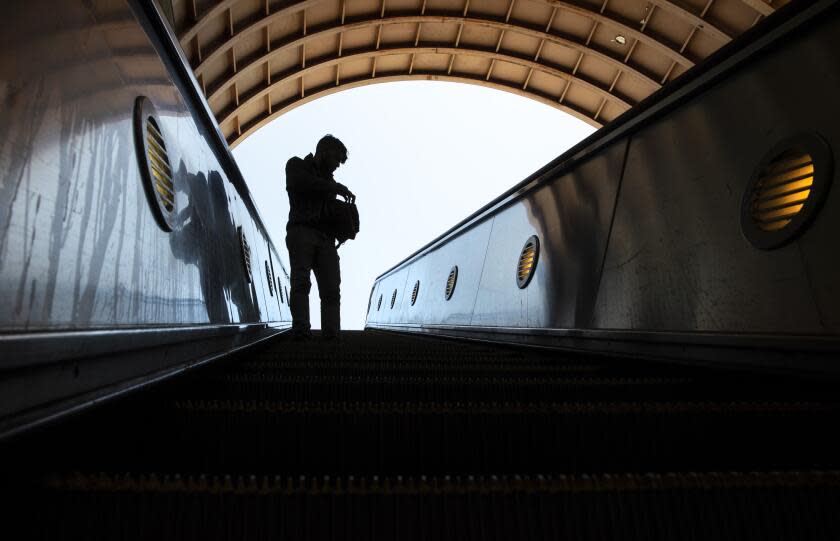Metro board ponders facial recognition, other security measures after subway killing

Transit officials are looking at facial recognition technology and fare gates as they scramble to find a way to secure the Metro system after a grandmother was fatally stabbed on the subway this week. The suspect arrested in the killing of 66-year-old Mirna Soza had once been banned from the system by a court order.
Distressed by her death and a rash of attacks, the Los Angeles County Metropolitan Transportation Authority's board on Thursday asked its staff to look into a litany of measures to beef up security on the sprawling system, including creating a protocol for communication among law enforcement agencies, examining the feasibility of facial recognition devices, and securing station gates.
"Our agency has grappled with a very real and unacceptable level of violence, illicit drug use sales and overdoses, and a blatant disregard for the law, our code of conduct and, quite frankly, basic human decency," said board member and Los Angeles County Supervisor Kathryn Barger, who initiated the effort. "Until we completely reverse security reality on our system, I'm concerned that we will never come back."
Ridership that cratered during the COVID-19 pandemic has been steadily rising, and many passengers don't have cars or other options to move around the city.
"There is no acceptable reality in which those solely relying on our system should have to endure this level of fear and indecency," she said.
"I hate to say it. I will not ride our transit system by myself. I am afraid. And I sit on Metro," Barger said. "It may be perception, but perception becomes reality. And it shouldn't be that way."
Read more:'Help me, help me': Metro bus driver stabbed, reviving fears about safety
The measures are part of a larger conversation within the agency on safety as it considers creating its own police force while balancing the concerns of critics who say law enforcement is heavy-handed and unfairly targets people of color, particularly Black men, and homeless people.
Metro's top security official, Robert Gummer, told its board Thursday that there's no system in place to alert Metro security or law enforcement when a judge issues an order banning a person from the system.
"We pretty much are left to just hoping that somebody at probation department or somebody at the district attorney's office or a court clerk remembers to send over a copy?" asked board member and Los Angeles City Council President Paul Krekorian.
"Absolutely," Gummer answered.
In the day leading up to the meeting, there had been several attacks, including one against a passenger who was beaten and found by a train driver around 12:30 p.m. Wednesday on the A Line at Washington Boulevard and Central Avenue. Around the same time, there was a stabbing at the A Line's Florence station.
The agency had been making strides in reducing crime, but the recent attacks have created a whole new crisis for the board as it continues to expand its rail system and begins to implement ambitious climate goals.
On Thursday, the board green-lighted environmental clearances for the first segment of the Southeast Gateway Line, a 14.5-mile light rail line through the heart of the southeast county, where some fear carless residents could be squeezed by gentrification and soaring rents. And it is moving forward to achieve a zero-emission bus fleet by 2030.
But again and again, several board members said the issue of safety needs to take top priority.
"Metro continues to build back to pre-pandemic levels, but if we want to ensure that these trends continue, we have to ensure that riders that are returning to our system are safe," said board chair and Los Angeles Mayor Karen Bass, who opened the meeting with a moment of silence to remember Soza, a migrant from Nicaragua who worked as a security guard and had been saving up to return to her homeland.
Transit agencies across the country are grappling with crime, said Anastasia Loukaitou-Sideris, interim dean at the UCLA Luskin School of Public Affairs.
"A lot of riders came back, but nothing to the pre-COVID levels, and then you have a few well-publicized shootings, and that makes everybody nervous," she said.
She doesn't see public transit as more unsafe than other environments and thinks adding facial recognition technology will only stir privacy concerns. But other countries have used gun detection technology, and she thinks fare gates and more ambassadors may help.
"Transit environments are really very open environments, everybody can get in and enter, and if you try many of these measures, you put delays into the system," she said. "The public is not going to like it. So it's a dilemma."
This story originally appeared in Los Angeles Times.
